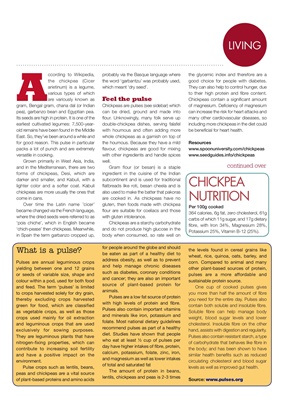
KITLIVING
Per 100g cooked
364 calories, 6g fat, zero cholesterol, 61g
carbs of which 11g sugar, and 17g dietary
fibre, with Iron 34%, Magnesium 28%,
Potassium 25%, Vitamin B-12 (25%).
CHICKPEA
NUTRITION
continued over
According to Wikipedia,
the chickpea (Cicer
arietinum) is a legume,
various types of which
are variously known as
gram, Bengal gram, chana dal (or Indian
pea), garbanzo bean and Egyptian pea.
Its seeds are high in protein. It is one of the
earliest cultivated legumes: 7,500-yearold remains
have been found in the Middle
East. So, they've been around a while and
for good reason. This pulse in particular
packs a lot of punch and are extremely
versatile in cooking.
Grown primarily in West Asia, India,
and in the Mediterranean, there are two
forms of chickpeas, Desi, which are
darker and smaller, and Kabuli, with a
lighter color and a softer coat. Kabuli
chickpeas are more usually the ones that
come in cans.
Over time the Latin name 'cicer'
became changed via the French language,
where the dried seeds were referred to as
'pois chiche', which in English became
'chich-pease' then chickpeas. Meanwhile,
in Spain the term garbanzo cropped up,
What is a pulse?
probably via the Basque language where
the word 'garbantzu' was probably used,
which meant 'dry seed'.
Feel the pulse
Chickpeas are pulses (see sidebar) which
can be dried, ground and made into
flour. Unknowingly, many folk serve up
double-chickpea dishes, serving falafel
with houmous and often adding more
whole chickpeas as a garnish on top of
the houmous. Because they have a mild
flavour, chickpeas are good for mixing
with other ingredients and handle spices
well.
Gram flour (or besan) is a staple
ingredient in the cuisine of the Indian
subcontinent and is used for traditional
flatbreads like roti, besan cheela and is
also used to make the batter that pakoras
are cooked in. As chickpeas have no
gluten, then foods made with chickpea
flour are suitable for coeliacs and those
with gluten intolerance.
Chickpeas are a starchy carbohydrate
and do not produce high glucose in the
body when consumed, so rate well on
Pulses are annual leguminous crops
yielding between one and 12 grains
or seeds of variable size, shape and
colour within a pod, used for both food
and feed. The term 'pulses' is limited
to crops harvested solely for dry grain,
thereby excluding crops harvested
green for food, which are classified
as vegetable crops, as well as those
crops used mainly for oil extraction
and leguminous crops that are used
exclusively for sowing purposes.
They are leguminous plants that have
nitrogen-fixing properties, which can
contribute to increasing soil fertility
and have a positive impact on the
environment.
Pulse crops such as lentils, beans,
peas and chickpeas are a vital source
of plant-based proteins and amino acids
for people around the globe and should
be eaten as part of a healthy diet to
address obesity, as well as to prevent
and help manage chronic diseases
such as diabetes, coronary conditions
and cancer; they are also an important
source of plant-based protein for
animals.
Pulses are a low fat source of protein
with high levels of protein and fibre.
Pulses also contain important vitamins
and minerals like iron, potassium and
folate. Most national dietary guidelines
recommend pulses as part of a healthy
diet. Studies have shown that people
who eat at least ½ cup of pulses per
day have higher intakes of fibre, protein,
calcium, potassium, folate, zinc, iron,
and magnesium as well as lower intakes
of total and saturated fat
The amount of protein in beans,
lentils, chickpeas and peas is 2-3 times
the levels found in cereal grains like
wheat, rice, quinoa, oats, barley, and
corn. Compared to animal and many
other plant-based sources of protein,
pulses are a more affordable and
sustainable protein source.
One cup of cooked pulses gives
you more than half the amount of fibre
you need for the entire day. Pulses also
contain both soluble and insoluble fibre.
Soluble fibre can help manage body
weight, blood sugar levels and lower
cholesterol. Insoluble fibre on the other
hand, assists with digestion and regularity.
Pulses also contain resistant starch, a type
of carbohydrate that behaves like fibre in
the body; and has been shown to have
similar health benefits such as reduced
circulating cholesterol and blood sugar
levels as well as improved gut health.
Source: www.pulses.org
the glycemic index and therefore are a
good choice for people with diabetes.
They can also help to control hunger, due
to their high protein and fibre content.
Chickpeas contain a significant amount
of magnesium. Deficiency of magnesium
can increase the risk for heart attacks and
many other cardiovascular diseases, so
including more chickpeas in the diet could
be beneficial for heart health.
Resources
www.spoonuniversity.com/chickpeas
www.seedguides.info/chickpeas